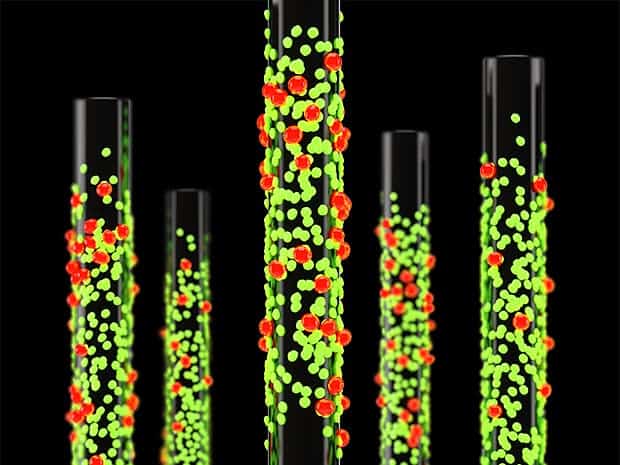
The backbone of today’s modern telecommunication industry is held by fiber optic cables. These information highways have accelerated data transfer and help people all over the globe stay connected, but that’s not all they’re good for. A group of international researchers are exploring the idea of using fiber optics as a lab-on-chip device. The tubes would be inserted directly into a patient’s veins, then built-in chemical sensors would detect signature molecules. Essentially fiber optics might become a cheap, ready available light-based diagnosis tool, with far reaching consequences.
If you ever took a blood test you know that it takes at least a couple of days, even weeks before your results come in. That’s because even though collecting your sample only took a minute, the underlying process that follows is far more complicated. Before your cholesterol results are delivered to you, the blood sample needs to pass through bulky and expensive lab equipment, typically operated by a trained technician. This is why blood tests are so damn expensive or why health care as a whole is getting more expensive. What about rural or isolated communities that can’t afford hundreds of thousands of dollars worth of equipment or can’t the staff skilled labor to operate the diagnosis machinery?
One possible solution, proposed since the 1960’s and in constant development since, is the lab-on-chip. The idea is to manufacturer portable, cheap and easy to use laboratory equipment, preferably the kind that does all the work on the spot in a reliable manner. The lab would include an instrument for reading out results and an array of attachable microsize probes for detecting molecules in a fluid sample, such as blood or saliva. Each probe could be used to diagnose one of many different diseases and health conditions and could be replaced for just a few cents.
Using integrated circuits inside the human body doesn’t seem very reliable however. Our insides are wet and semiconductor materials risk becoming corroded, malfunctioning the whole mini-lab array. Also, with all of today’s modern tech we still can’t fit power sources, processors, and transmitters in less than a few square centimeters – that’s much too big to squeeze through blood vessels. A glass optical fiber doesn’t have these limitations, however – more or less the same as the ones that already span the globe, ferrying voluminous streams of data and voice traffic at unmatchable speeds.
Measuring light to find diseases
By using light rather than current to read chemical reactions, a photonic chip works reliably in aqueous solutions, is immune to electromagnetic radiation, tolerates a wide range of temperatures, and poses fewer risks to biological tissues. A group at Carleton University, in Ottawa, Canada is currently developing a practical solution for lab on fiber that is easy to make and outputs precise measurements.
It all begins with a standard communications fiber optic cable which is coated on the inside with tiny amounts of germanium oxide, which raises its refractive index, a measure of the speed of light in a material, while the outer cladding is encased in a protective polymer jacket. Fiber optics are so great for data transmission because light doesn’t get lost through the tube’s walls; instead it gets constantly scattered in the core so the signal remains strong. For their lab on fiber approach, the group however need to bind probe segments to the fiber’s core for it to act as a chemical sensor.
Coating this segment probe with a chemical compound, called a reagent, allows the fiber to bind with target molecules we want to measure, such as blood enzymes or food additives. As light travels through the fiber, some of the light comes in contact with the molecule binding coating which changes the light’s properties. Then by analyzing the characteristics and magnitude of these changes with a standard spectrometer, we can determine the concentration of molecules reacting with the probe.
According to the researchers involved in the research, the lab on fiber is very accurate as some target molecules were detected with concentrations as low as 2 nanograms per liter which translates to roughly a pinch of table salt in a 25-meter swimming pool. Elsewhere, a group reported in 2012 that using a similar set-up they were able to detect the smallest possible variations in snippets of DNA, suggesting the fiber on lab could be used for quick and accurate genetic screening for complex conditions such as cystic fibrosis, cancers, and certain infections.
It might take a while before we see it applied to humans, though, as there are still many challenges that need to be addressed like how to make the coating thick enough to last for months inside the body. A more immediate application is in the industrial sector where it the fibers could be implemented inside machinery or important pipelines.
Source: Spectrum IEEE






